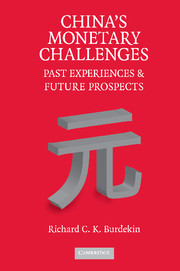Book contents
- Frontmatter
- Contents
- Preface
- Introduction: China Today and Lessons from the Past
- PART I CHINA'S EXCHANGE RATE REGIME AND MONETARY POLICY
- PART II THE IMPORTANCE OF INTERNATIONAL FACTORS, PAST AND PRESENT
- 5 US Pressure on China and Hong Kong in the 1930s
- 6 Inflation Transmission to Taiwan in the 1940s
- 7 WTO Challenges and China's Banking Sector Today
- PART III THE PEOPLE'S REPUBLIC'S ROLE WITHIN GREATER CHINA AND ASIA
- 10 Conclusions and Future Prospects for the Renminbi
- References
- Author Index
- Subject Index
5 - US Pressure on China and Hong Kong in the 1930s
Published online by Cambridge University Press: 06 July 2010
- Frontmatter
- Contents
- Preface
- Introduction: China Today and Lessons from the Past
- PART I CHINA'S EXCHANGE RATE REGIME AND MONETARY POLICY
- PART II THE IMPORTANCE OF INTERNATIONAL FACTORS, PAST AND PRESENT
- 5 US Pressure on China and Hong Kong in the 1930s
- 6 Inflation Transmission to Taiwan in the 1940s
- 7 WTO Challenges and China's Banking Sector Today
- PART III THE PEOPLE'S REPUBLIC'S ROLE WITHIN GREATER CHINA AND ASIA
- 10 Conclusions and Future Prospects for the Renminbi
- References
- Author Index
- Subject Index
Summary
At a time when other countries have been depreciating their monetary units…, China, whose currency is on a metallic basis, has seen the value of its monetary unit steadily appreciate…If the Chinese exporter is to retain his markets, it must be by marking down prices, thereby communicating the evils of deflation to producers throughout the country…Furthermore, heavy exports to silver have seriously contracted currency and credit in China, which makes for higher exchange and lower prices.
(Dr. H. H. Kung, China's Minister of Finance, October 10, 1935)Introduction
Although the post-2001 dollar depreciation discussed in Chapters 1 and 2 was not part of any officially declared government policy, the 40% devaluation of the dollar against gold in 1933–1934 reflected US policymakers' determination to free the economy from persistent deflationary pressures and was accompanied by a rapid acceleration of domestic money supply growth (cf. Friedman and Schwartz, 1963; Bernanke, 2002). This US monetary expansion was fueled by large-scale silver purchases, under which the US government issued silver certificates in exchange for the newly purchased silver – with these silver certificates then circulating as currency and adding to the nation's money supply. The US silver purchases had major implications for China as well. In the early 1930s, China and the British crown colony of Hong Kong were essentially alone in still linking their currencies to silver. As the world price of silver rose in response to the US silver purchase program, these silver-based currencies appreciated in value.
- Type
- Chapter
- Information
- China's Monetary ChallengesPast Experiences and Future Prospects, pp. 95 - 117Publisher: Cambridge University PressPrint publication year: 2008
- 1
- Cited by



